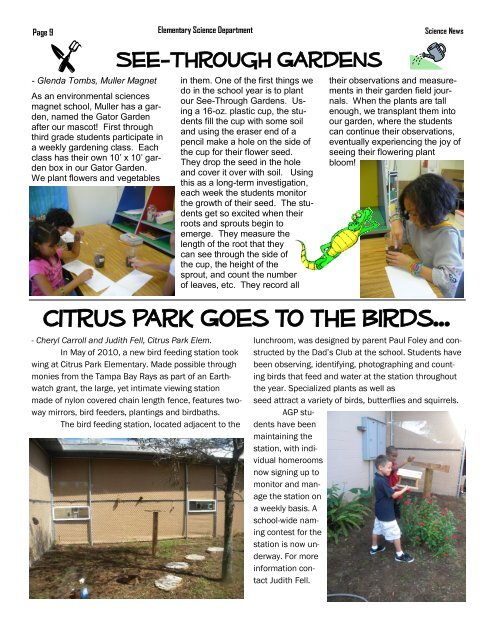SCIENCE NEWS - Mendenhall Elementary - Hillsborough County ...
SCIENCE NEWS - Mendenhall Elementary - Hillsborough County ...
SCIENCE NEWS - Mendenhall Elementary - Hillsborough County ...
You also want an ePaper? Increase the reach of your titles
YUMPU automatically turns print PDFs into web optimized ePapers that Google loves.
Page 9<br />
- Glenda Tombs, Muller Magnet<br />
As an environmental sciences<br />
magnet school, Muller has a garden,<br />
named the Gator Garden<br />
after our mascot! First through<br />
third grade students participate in<br />
a weekly gardening class. Each<br />
class has their own 10’ x 10’ garden<br />
box in our Gator Garden.<br />
We plant flowers and vegetables<br />
See-Through Gardens<br />
- Cheryl Carroll and Judith Fell, Citrus Park Elem.<br />
In May of 2010, a new bird feeding station took<br />
wing at Citrus Park <strong>Elementary</strong>. Made possible through<br />
monies from the Tampa Bay Rays as part of an Earthwatch<br />
grant, the large, yet intimate viewing station<br />
made of nylon covered chain length fence, features twoway<br />
mirrors, bird feeders, plantings and birdbaths.<br />
The bird feeding station, located adjacent to the<br />
<strong>Elementary</strong> Science Department Science News<br />
in them. One of the first things we<br />
do in the school year is to plant<br />
our See-Through Gardens. Using<br />
a 16-oz. plastic cup, the students<br />
fill the cup with some soil<br />
and using the eraser end of a<br />
pencil make a hole on the side of<br />
the cup for their flower seed.<br />
They drop the seed in the hole<br />
and cover it over with soil. Using<br />
this as a long-term investigation,<br />
each week the students monitor<br />
the growth of their seed. The students<br />
get so excited when their<br />
roots and sprouts begin to<br />
emerge. They measure the<br />
length of the root that they<br />
can see through the side of<br />
the cup, the height of the<br />
sprout, and count the number<br />
of leaves, etc. They record all<br />
their observations and measurements<br />
in their garden field journals.<br />
When the plants are tall<br />
enough, we transplant them into<br />
our garden, where the students<br />
can continue their observations,<br />
eventually experiencing the joy of<br />
seeing their flowering plant<br />
bloom!<br />
Citrus Park Goes to the Birds...<br />
lunchroom, was designed by parent Paul Foley and constructed<br />
by the Dad’s Club at the school. Students have<br />
been observing, identifying, photographing and counting<br />
birds that feed and water at the station throughout<br />
the year. Specialized plants as well as<br />
seed attract a variety of birds, butterflies and squirrels.<br />
AGP students<br />
have been<br />
maintaining the<br />
station, with individual<br />
homerooms<br />
now signing up to<br />
monitor and manage<br />
the station on<br />
a weekly basis. A<br />
school-wide naming<br />
contest for the<br />
station is now underway.<br />
For more<br />
information contact<br />
Judith Fell.


